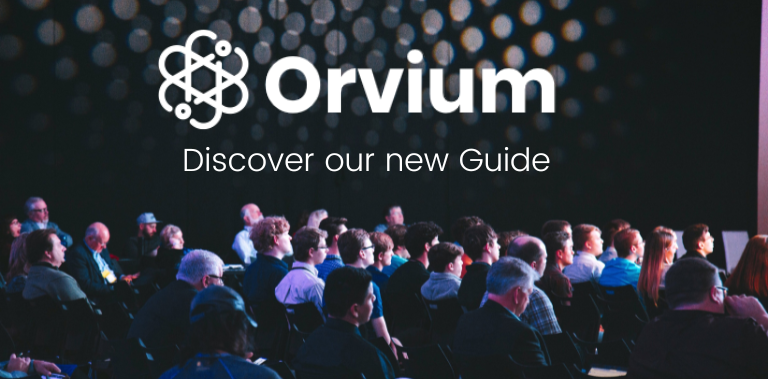How to Build a Content Strategy for an Academic Conference
The content consumed at conferences includes speaker sessions, social media posts, and any other related conference-specific content. As an organizer, you must be on top of posting, gathering relevant content, and ensuring attendees have plenty of content-related networking opportunities at your conference.
Therefore, a content strategy for academic conferences is multi-faceted. Most importantly, your content strategy must be good to ensure success now and for future events.
Since a good content strategy is a must-have for any conference organizer, this article will outline the four steps on how to build one and offer the best opportunities for conference content before, during, and after the event.
Building an Academic Conference Content Strategy in 4 Steps
Step 1: Create a vision of your conference
To build a sound content strategy, you must first establish your conference basics. Your basics will be the vision of your conference. Ask yourself questions like:
- What is the conference’s overarching theme, purpose, type, tagline, and color scheme?
- What are your audience demographics (age, location, profession)?
- What kinds of digital campaigns/content do you want to use, what will that look like, and how will you distribute it?
- Are you using an event/content management app?
Your conference basics will serve as the starting point for your content strategy. For example, the color scheme and theme can influence the colors of your digital communications (banners, social media posts, signage, landing page, etc.).
Remember, a good content strategy engages your attendees, sponsors, followers, and other stakeholders before, during, and after a conference.
Step 2: Poll attendees about topics
Once you have a good idea of your vision for the conference, you can conduct pre-event surveys and polls with your attendees. Consider polling attendees about sub-topics, topics, and subject matter knowledge. This will help you learn what type of content attendees want to see and learn about (it will also help you choose the most appropriate speakers for your conference). Furthermore, surveys can also get participants’ opinions on all of these ideas and topics.
Ask attendees questions like:
- What types of speaker sessions will be most valuable for you?
- How do you intend to increase your knowledge regarding this topic?
- What do you hope to learn from this conference?
- What are you most looking forward to at the conference?
Note: marketing and business development teams should be up-to-date on trends and subject matter issues currently drawing the most interest.
There are multiple ways to go about gathering necessary data:
- Set up an event Facebook or LinkedIn group and a polling feature
- Include survey questions in the event registration form
- Set up email marketing campaigns to send surveys or include a link to one of your polling features.
Step 3: Facilitate attendee engagement within the strategy
After you’ve collected enough information (and selected the appropriate speakers), you can start creating pre-conference content to interact with followers and attendees. Create a conference landing page with keywords related to your industry.
Include important conference information like who will be speaking, who is sponsoring your event, a link for tickets or a link to watch online, and social media handles and contact information.
Additionally, reach your attendees and followers on the platforms that make the most sense for your event and their demographics. These include:
- Email marketing
- Facebook, Twitter, LinkedIn, Instagram
- Pay-per-click (PPC) strategies
- Digital newsletters, blogs, articles, short podcasts, etc.
Step 4: Build the strategy with an all-in-one platform
Do you need some help with content creation, other ideas, or getting all of your data in one place? Consider using a content management app. A conference app helps with the following things:
- Understands attendee wants, needs, and interests
- Connects with attendees
- Helps attendees connect and network with each other.
Encourage attendees to use the app to plan their time at the conference to increase engagement prior to the event. Include features like a built-in calendar that makes conference information readily available, speaker bios, and ways to interact with or ask speakers or other attendees questions.
This will familiarize attendees with your app come conference day, and you can continue engaging them with content like networking opportunities or speaker slides on the day of. You may even consider including in-app speaker or organization evaluations during and after the event.
Best Content Opportunities for Conferences
Pre-Conference Content
Pre-conference content focuses on building up excitement and anticipation for your event. It’s best to do this over time, where you may consider introducing a keynote or session speaker each week to boost interest. Content options for this phase include:
Building community with social media
- event hashtags (personalized for your event with your name and theme, for example)
- TwitterChats - like this example from Content Marketing World (CMWorld)
- Facebook and LinkedIn groups
Produce epic content
- ebooks
- pre- and post-event blog articles
Develop crowd-pleaser posts that are grounded in data
- lists and interviews with influencers or industry experts or researchers.
During Conference Content
During the conference, it’s just as important to ensure attendees are using the same tactics as before the conference, and ensure you add:
Live presentations
- include (pre-formatted) social media shares/posts in your presentation
- consider using speaker quotes on Twitter
- pre-schedule social shares during the presentation to help attendees follow your talk
- enhance your presentation with shortened URLs
Visual notetaking
- include hand-drawn summaries from speaker sessions that attendees can snap and share
Live blog sessions to leverage others’ expertise
- encourage speakers and others who follow the conference to use the event hashtag when sharing live sessions to give those who weren’t able to attend an inside scoop
On-the-go content at the event
- take photos or record videos of something funny or interesting happening at the event
- consider including a photo booth for added entertainment and social media opportunities.
Post-Conference Content
Your event is over! However, you don’t have to stop (and shouldn’t) posting quality content from the conference. Here’s how to keep the momentum going:
Write post-conference articles
- include a good hook, add good content, photos, audio, or video, and give speakers and attendees a shoutout
Share conference presentations
- encourage speakers to share their presentations with attendees to inspire inclusivity
Follow up with people you’ve met (not just sponsors or speakers)
- send a personal note to someone you spent a while talking to (write their name and information on a post-it, so you don’t forget)
Present compiled interviews
- include a fun Q&A and takeaways that you can share year-round.
Orvium Educates and Informs
Conferences are a great way to get your attendees to pay attention to your content. And regardless of which strategies work best for you and your event, your event and attendees may suffer without a good conference content strategy. Orvium understands conferences and how important it is to have a good content strategy.
Improve your Conference with our New Guide

That’s why we've elaborated the Full Guide to Planning an Academic Conference. If you are preparing a conference and you need to know more about how to do it without leaving anything out, at Orvium we have made this complete guide where you will find answers to your questions.
To download the guide just click on the button below, fill in a simple form, and you will receive the guide in your email.
Make sure to also check out our platform to see our most recent publications




